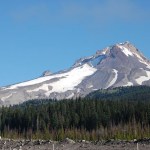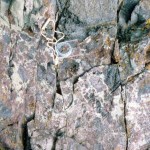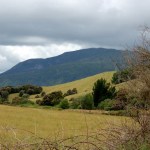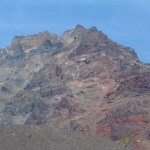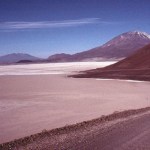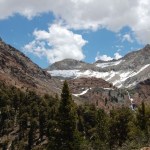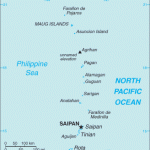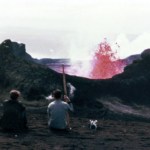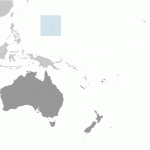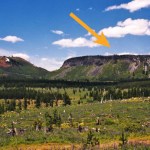Karangetang in Indonesia erupting in June of 2007.
This year we haven't had a lot of news about volcanic activity in Indonesia. This is not to say that eruptions haven't been happening, rather they just haven't been in the news. If you check out the current status of the volcanoes of Indonesia, you'll see that no less than six volcanoes are on orange (Level 2) status and another fourteen are on yellow (Level 1 - and there is a Level 0 as well). So, it is a active arc as arcs go (compare that to the Aleutians or Cascades).
This means that it should come as little surprise that Karangetang on…

A new Weekly Volcanic Activity Report from the Smithsonian and USGS Global Volcanism Program!
Highlights from this week's report include:
Things are getting a little noisy in Colombia. I mentioned a few weeks ago about a possible explosion at Nevado del Ruiz. Now we have reports of increased seismicity under nearby Cerro MachÃn and ash plumes from Nevado del Huila. After a few centuries of relative quiet, it looks like the volcanoes of the Colombian Andes are looking more lively.
Also in South America, a gas plume was spotted at Chile's Planchon-Peteroa. This is the second time this year…
Eyjafjallajökull erupting in the spring of 2010.
I have a request for all of you Eruptions readers! In a few weeks I will be giving a talk here at Denison on the Eyjafjallajökull eruption and especially the aspects of how the eruption unfolded on the web. I think the shared experience of the seismicity, fissure vent eruption and explosive eruption - along with all the ramifications of the air traffic stoppage over Europe - was a fascinating phenomenon. So, I ask you readers: How would you describe your experience on Eruptions during the Eyjafjallajökull events? By that I mean in terms of…
Mt. Hood in Oregon, taken August 2008. Image by Erik Klemetti. Click on the image to see a larger version.
Quick news!
I'm not going to go into too much depth right now about the recent study published in Nature Geoscience on Mt. Hood in Oregon - I plan to talk about it more in a few weeks. Why is that? Well, the lead investigator on the study, Dr. Adam Kent of Oregon State University, is a friend of mine (and occasional Eruptions commenter) so I plan to get the details from him before posting. I was also peripherally associated with some of this work - mostly in the field acting as a pack…
Mt. Elbrus in southern Russia, one of the active volcanoes in the Caucasus Mountains. (Note the prominent flow levees sticking out of the snow cover on the dacite lava flow in the middle of the image.)
Most people (including myself) aren't fully aware of the active volcanoes in the Caucasus Mountains, but sure enough, there are volcanoes that have erupted fairly recently (geologically-speaking). One of the active volcanoes in the Caucasus Mountains of Russia is Mt. Elbrus, just north of the border with Georgia, and it has erupted as recently as ~50 A.D., which for a volcano is the blink of…
Continuing my series where I try to define words of volcanic interest, the new Eruptions Word of the Day is a favorite of mine, mostly because my undergraduate thesis on Vinalhaven Island in Maine ended up dealing with a lot of these types of deposits ... so, without further ado, the word is peperite!
Now, what exactly is a "peperite"?
Well, a picture is worth 1,000 words, right (so that will save me some time):
Peperite in the Vinalhaven Diabase, Vinalhaven Island, Maine. Image by Erik Klemetti. Click on the image to see a larger version.
Let's make some observations:
The rock is full of…
Lots of little pieces of news I've run across ... time to play a little catch up.
Stromboli: A volcano after Don Ho's heart.
Every once in a while, my RSS feeds will dredge up some articles from years gone by ... and this week there were two New York Times pieces that are a few years old, but interesting nevertheless. The first is about research conducted by Dr. Robert Sohn at WHOI on explosive undersea eruptions. The second is work by Corr and Vaughan about finding subglacial volcanism in Antarctica. Both are interesting reads if you missed them (like I did) the first time around.…
Lava flows from Kilauea in Hawai`i move towards a home in Kalapana.
Whenever I think about the hazards posed by most lava flows, I tend to think about the opening scene in the Hitchhiker's Guide to the Galaxy. Developers are planning to knock our hero Arthur Dent's house down and as a last ditch effort to stop its destruction, Arthur lies down in front of the bulldozer. The demolition supervisor, a certain Mr. Prosser, at one point asks Arthur if he knows how much damage the bulldozer might suffer if he just lets it roll over poor Mr. Dent. Arthur says he doesn't know and Mr. Prosser replies…
When we last left MVP, the latest entry actually did give people some trouble - but Don Crain ended up landing the winner at guess #15. The volcano is Ollagüe along the Chilean/Bolivian border. I took this shot from the road that comes up from the south towards Ollagüe (the town). Now, I have been to Ollagüe (the town) in almost 10 years now, but I did stay in a "hotel" called the Hotel Brin Bran - good soup, surly owner, nice view of both Ollagüe (the volcano) and Aucanquilcha. Definitely the vacation spot if you're visiting the high Andean Chilean/Bolivian frontier.
So, our standings:…
The northern Chilean and southern Peruvian Andes are full of volcanoes that look stunning - I mean, jaw-dropping details of volcanism litter the landscape. The reason for this is two fold: (1) there is an awful lot of volcanism in the northern Chilean/southern Peruvian Andes (as known as the Central Volcanic Zone) - and has been that way for over 10 million years and (2) it has also been very, very dry in the area (most of which is known as the Altiplano-Puna Plateau) for at least a few millions years as well - it is the home of the Atacama Desert! So, this means you get lots of volcanic…
Tourists hiking next to an active lava flow on Pacaya in Guatemala in 2006.
I'm flying back to Ohio today after a successful few weeks of fieldwork/paper writing. Apparently I have a pile of tomatoes waiting in our garden in Granville ... !
On to news:
To go with the news that lava flows from Kilauea creep ever closer to structures in Kalapana, the NASA Earth Observatory posts its first volcano image in a bit. The shot shows the steam-and-gas plume from the Halema`uma`u Crater in Kilauea's summit caldera. You can also see some video of the lava flows near Kalapana as they move along the…
One of the commemorate Eyjafjallajökull ash stamps being issued by the Icelandic Post - made with ash from the eruption itself.
Many Eruptions readers would consider themselves volcanophiles (or volcanificiandos?) and I would venture to guess there is a subset of volcano enthusiasts who are also philatelists as well. A philatelist (for those of you out of that select circle) is a stamp enthusiast - a stamp collector. Now, in our modern interwebbed world, I wonder if stamp collecting as a hobby has diminished, but that doesn't stop countries from still trying to make some money from stamp…
Kilauea lavas on the move near Kalapana. Image taken July 17, courtesy of the Hawaiian Volcano Observatory.
Some news over the last few days:
The lava flows from Kilauea are moving with a vengeance right now, damaging roads and heading for some structures. The lava flows near Kalapana have moved almost 200 meters since Sunday, closing within 100 yards of homes in the area. The lava is moving to the east along Highway 130 and 137 - and tourists are making it difficult to get around as they park to watch the lava - upwards of 2,000 people! A number of people (and dogs) have had to be…
OK, first off an apology for this week: I will be kind of crazy busy while in Davis - two papers to churn through so we can get them submitted sometime this summer, so blogging may be minimal. So, remember, whenever you hear people talk about how professors have it easy because they get the summer "off" ...
Second off, another apology: Dr. Ed Kohut went to Boston College, not Boston University. You would have thought I could keep that straight, but alas, I confuse my Eagles with my Terriers.
Mea culpa to all!
Anyway, I have to send out a hearty congratulations to Boris Behncke destroying my…
I'm officially out of the mountains in the Mineral King area - the field work went great, we collected some fabulous Triassic-Jurassic rhyolites from a pendant in the Sierra Nevada Batholith (and also enjoyed blueberry-sized hail and an unfortunate hike through a thorny thicket). I'll have more to say later, but now I'll be diving headlong into working on papers during my few days here in Davis ... but I'll try to catch up on all your comments left while I was away!
The Mineral King region of the Sierra Nevada in California. Click on the image to see a larger version. Image by Erik Klemetti…
Our tour of the Marianas begins SW of Guam. In this area the volcanoes are submerged and make up a region known as the Southern Seamount Province. Our first stop is Tracey Seamount, which lies 30 km west of Guam. Tracey is a ~2 km tall cone and volume of ~45 km3 It is one of the smaller volcanoes in the Mariana arc; Pagan, contains about 2200 km3 of material (Bloomer et al., 1989). It has a sector collapse on its western flank and resembles a submarine Mt. St. Helens. It was investigated by the ROV Hyper-Dolphin from the R/V Natsushima in Feb. 2009, which revealed that the cone is map up of…
MVP 23 revealed ... and 24 introduced!
Mystery Volcano Photo #23 was, in fact, Middle Sister volcano in Oregon, part of the picturesque Three Sisters near Bend. Middle Sister is a partially eroded (by glaciers) composite volcano with a mix basaltic andesite to andesite lava flows and tephra deposits. Depending on who you speak with, Middle Sister gets lumped in with North Sister (as Middle Sister build up on the flanks of its slightly older sibling) or stands on its own as a part of the Three Sisters. However, before thinking Middle Sister is dormant, remember, the last eruption might have…
This week I welcome Dr. Ed Kohut as a guest blogger here on Eruptions (while I am off in the Sierras doing some field work). I've known Ed for 10 years now - we were both graduate students in igneous petrology at Oregon State University - and we are both Massachusetts natives. Ed was in the Coast Guard before getting degrees at University of Rhode Island and Boston University before heading of to Oregon State for a Ph.D., where he worked on melt inclusions in minerals. One of his major research areas is magmatism in the Mariana Islands and he was nice enough to put together a look at the…
The latest Eruptions Word of the Day is "Tuya".
So, what is a tuya?
This is a tuya:
A tuya! Click on the image to see a larger version. Image by Erik Klemetti.
Alright, well, that doesn't entirely help, does it?
Lets look at the feature the arrow indicates. Some observations:
(1) It is low and broad.
(2) It has a relatively flat top.
(3) It is steep-sided.
(4) If you look real close, you can see crudely columnar jointing in the some of the outcrops near the top.
(5) If you had a piece of it in your hand, you'd know it was a volcano rock (andesite, very rarely you can find bits that are quite…
New eruption? New volcano research announced? New media attention put on all things volcanic? Post it here and feel free to discuss ...
I'll be back July 20.
